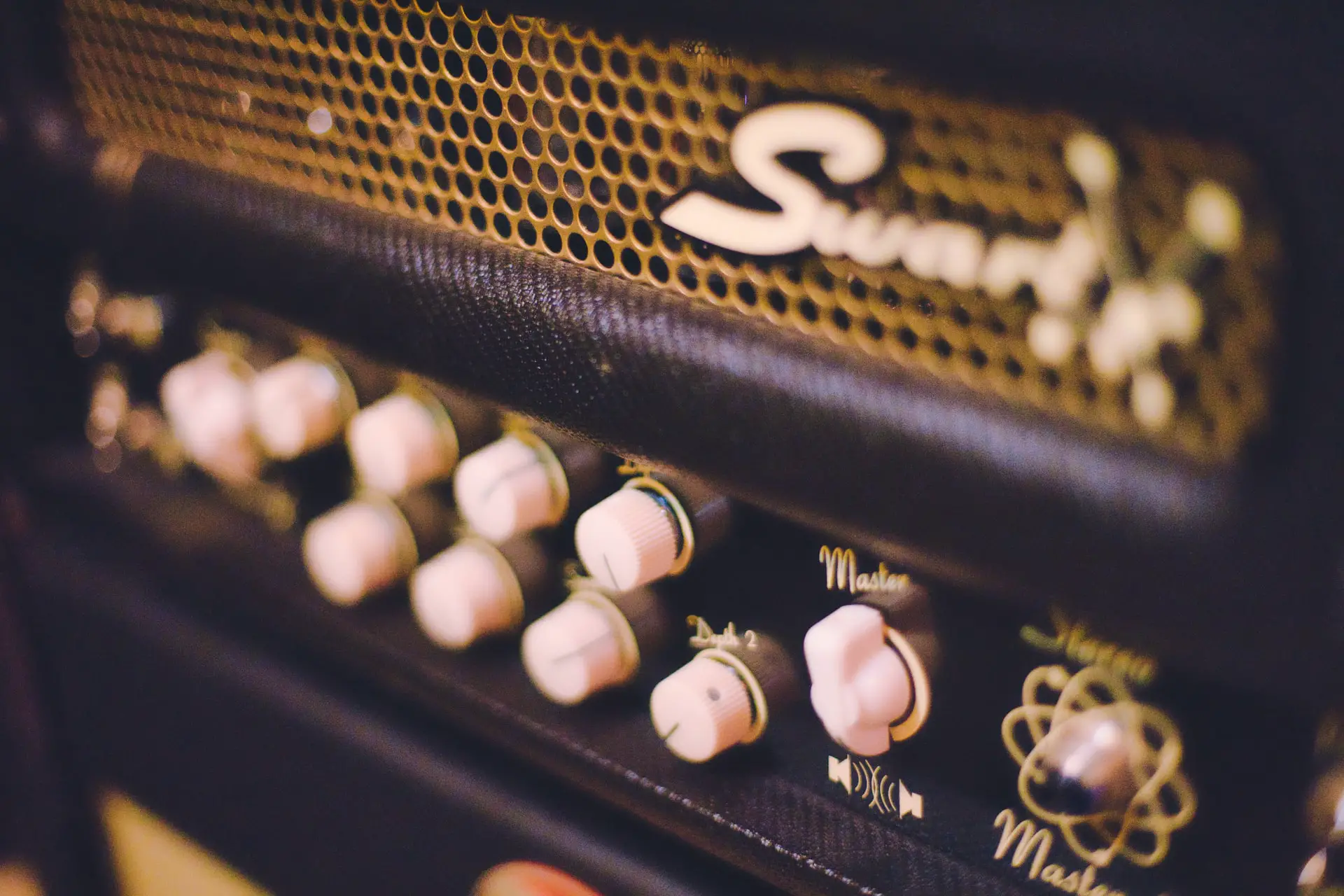Amps are generally better than an audio interface if you simply want to play and practice. There’s no complicated configuration with amp – just plug and play.
However, if you want to record and use various sound effects, then an audio interface is better.
Both amps and audio interfaces have their own pros and cons. Actually, they should be used and treated differently.
However, I do understand why it gets confusing and why they are compared with each other. An audio interface can completely replace the amp if you want to – but should you do it?
I have played around with both an amp and audio interface quite extensively. In this article, I will compare the amp and audio interface side-by-side. This should be helpful in clarifying differences between them – especially for the beginners.
Let’s first talk about an amp and audio interface individually – what do they do exactly?
What Does An Amp Do?
Amp stands for ‘amplifier’ – it’s a tool that amplifies weak sound signals coming from your guitar into stronger signals that can be played through a speaker or headphone.
Every time you strum or pluck a guitar string, they generate a weak sound signal that’s picked up by the guitar bridge.
This sound signal is then transferred into the amplifier to be made significantly stronger and played through speakers by your amp.
Majority of guitar amps already come equipped with speakers – which is why you don’t need a separate speaker with guitar amps.
Most beginner electric guitar players start with an amp first. It’s simple – you just plug and play. Many beginner guitar sets also come with an amp – in fact, this is the guitar set that I purchased when I started out.
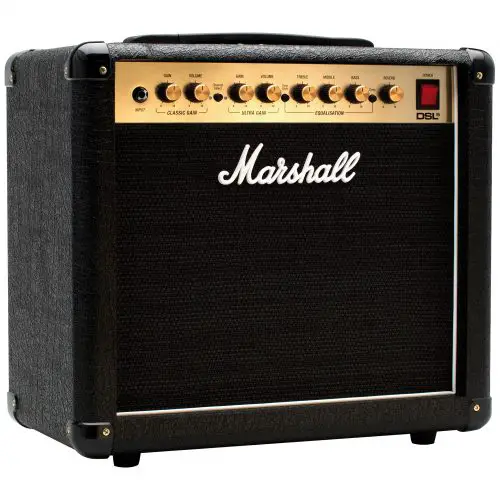
Amplifier empowers weak sound signal to be loud enough for speaker.
What Does An Audio Interface Do?
Audio interface is a tool that converts analog signals coming from a guitar (or any other source) into digital signals used by a computer.
Once connected, the computer can apply effects and change the sound from your guitar. A computer can even emulate an amp and play the sound to the computer speakers – these are all done through audio interface software and plugins.
This means an audio interface can replace an amp if you want to – but the emulated sound will not be 100% the same. Many people still use regular amps because of the unique sound.
You can also use an audio interface simply to record the sounds coming from your guitar. This is useful if you want to produce music or simply upload your playing into social media!
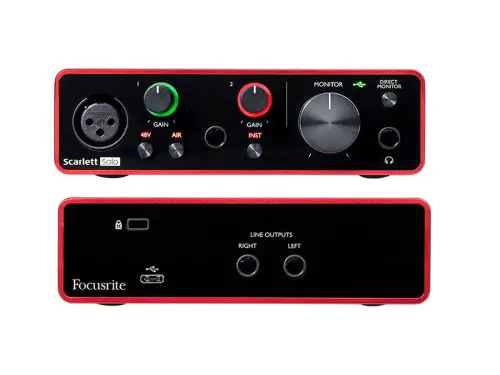
Guitar interface translates analog sound signal into digital signals used by computer.
Amp Vs Audio Interface
Audio interfaces tend to have better sound quality than amps because you can process it more later with the computer.
However, audio interfaces may have latency issues depending on your computer and sound cards. You need a relatively powerful computer to process the sound without delay.
Amps are simpler to use and suitable for beginners who just want to practise. Whereas audio interfaces are more complicated but you can use it to record audio, add cool effects with countless plugins.
In this section, I will compare the amp and audio interfaces in different criteria. Here’s the summary table, you can scroll a little and find more explanation for each criteria.
| Amp | Audio Interface | |
| Sound Quality | Good | Better |
| Price | $49 – $199 | $49 – $399 |
| Setup | Simple | Complicated |
| Latency | Low | Prone to more latency |
| Headphone Connection | Yes | Yes |
| Portable | Yes | No |
Amp Vs Audio Interface: Sound Quality
Sound quality going through an audio interface could be better than an amp because of the further processing that can be done later in the computer.
If you are looking to record sound, then using an audio interface will definitely provide better sound quality than just recording the sound coming from your amp speaker.
If you are looking to just play the guitar, then an audio interface can also provide better sound quality than an amp.
With audio interfaces you can use thousands of available amp models, effects and plugins to improve the sound. (with amp, there’s no chance of processing)
When talking about raw sound quality, then it depends on the preamp inside the audio interface.
Similar to a regular amp, sound signals coming from the guitar need to be amplified first by a ‘preamp’. Depending on this preamp, your audio interface can receive a good or bad sound quality.
Generally, more expensive audio interfaces have better preamp – allowing them to receive better sound with wide dynamic range.
Amp Vs Audio Interface: Price
Both amp and audio interface are priced generally the same. You can get the cheaper or more expensive options. They both start at $49 and can go up to thousands for the real pros.
Price of an amp and audio interface depends on you. If you are a beginner that just needs to play and practice, then a $99 Fender amp or $100 Focusrite audio interface are good enough.
If you are more experienced and really care about the sound quality, then the price of the amp and audio interface can go up significantly.
My personal opinion – if you are playing in a band or need to perform regularly, then an expensive amp or audio interface is definitely worth it. Especially if you want to produce high quality sound that’s played through big speakers.
If you are just playing at home as a hobby – regardless of how good you are, I think a regular amp or audio interface are good enough. Get those in the $100 – $200 range – don’t go any higher.
If you have more budget, you can even get both audio interface and amp – experience both, it will be worth it.
Amp Vs Audio Interface: Setup
An amp is significantly easier to set up than an audio interface. With an amp, it’s just plug and play. With an audio interface, you need to worry about drivers, updates, latencies and expensive software plugins.
Amp is a very simple tool. In most cases (especially for beginners), you just have to plug your guitar chord in, adjust some gain and volume knobs – and you are good to go.
There’s no hassle with latency or tuning for sound quality and effects for amp. It will just work well. Of course, the options become limited. You can’t play too many effects but they should be good enough to hone your skills.
On the other hand, an audio interface is complicated to set up. You need to connect the guitar, into the sound interface and into the computer.
In your computer, you will need to install correct drivers, software and sound plugins to produce your effects. Not to mention, you also need to worry about latency. Weak computers will produce bigger latency.
These issues on the audio interface are non-existent on amp. If you don’t want the headache, regular amps are definitely the way to go.
Amp Vs Audio Interface: Latency
You won’t have latency issues when using a wired amp. On the other hand, when using audio interfaces, you need to make sure your computer is powerful enough to bring the latency down.
Amps are simple tools that amplify sound signals in real time. You won’t have latency issues with a wired amp. Just plug and play.
With wireless amps, you may have latency issues – depending on the equipment you bought and how far away you are from it. The further you are, the more latency (especially if there’s a separator like wall)
With audio interfaces, the heavy processing work is done by your computer. The more effects and complicated processing you have, the more latency there will be.
I wouldn’t recommend you buy special computers or laptops to use with an audio interface. Just make sure your software setup is not too heavy and you should have no issues with latency.
To reduce audio latency, you need to keep in mind the points:
- Reduce buffer size
- Increase sample rate
- Don’t use wireless devices like Bluetooth
I found a great article by Ableton on reducing latency when using audio interface here.
Amp Vs Audio Interface: Headphone Connection
Both amps and audio interface commonly support headphone connection out of the box. Just find the headphone jack input and plug your headphones in.
Though many amps and audio interfaces support only a ¼ inch audio jack. Which means you will need an audio jack converter (3.5mm to ¼ inch).
Related article: Playing Guitar With Headphones: Is It Bad? (Pros & Cons)
Amp Vs Audio Interface: Portable
Amp is more portable than an audio interface. When playing in different rooms or locations, you can simply carry the amp and plug in to play. With an audio interface, you need the interface and your laptop as well.
Audio interfaces work together with a computer. Which means, if you want to play with an audio interface, you need to move the audio interface and laptop as well.
If you prioritize being portable, you can opt for a headphone amp or a mobile audio interface. These are smaller versions of an amp or audio interface that you can carry and play anywhere.
For a portable headphone amp, I recommend the Vox AmPlug (AC30). You just plug the Vox AmPlug into your guitar and you plug your headphone directly into the Vox Amplug. With this setup, you no longer need the bulky amp.
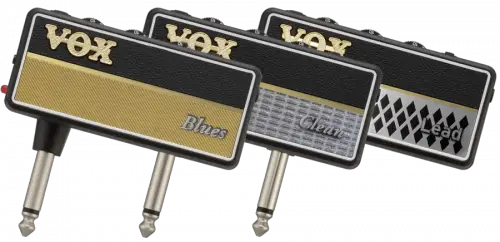
Vox Amplug is a portable amplifier for headphones.
For a portable audio interface, I recommend the Guitar Link audio interface. It’s a small and super cheap device that connects your guitar directly to your phone.
You can then use mobile apps like Deplike or Amplitube to add sound effects and play the sound to your headphones.
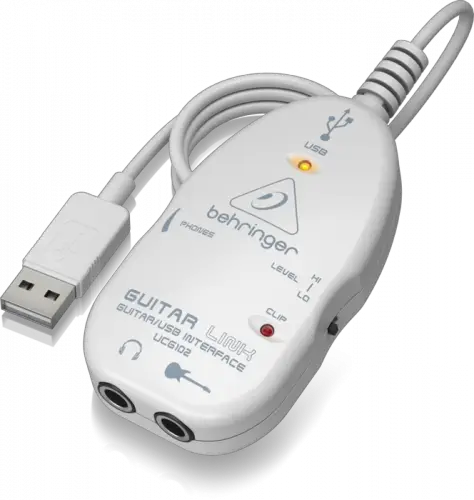
Guitar link is a cheap audio interface (typically used with mobile phones)
Can Audio Interface Replace Amp?
An audio interface can definitely be replaced with an amp. You just need an audio interface and amp modeler software like Amplitube. However, the setup becomes a little more complicated.
If you simply want to practise with an audio interface, I recommend you get the Guitar Link for Android or iRig for iphones. They are proven to work well and they are portable.
This is how the setup will be:
- Connect guitar to Guitar Link (Audio Interface) or iRig
- Connect headphones to Guitar Link or iRig
- Setup amp modeler using apps like Deplike
- Play guitar
In total, this setup costs about $50. And because it’s a software, you can always get different amp models for different effects from the app. (You don’t have to buy any more new hardware).
Note: You may need to also get a 3.5mm to ¼ inch adapter and USB to USB-C converter if you are using the amp modeler app from a mobile phone.


